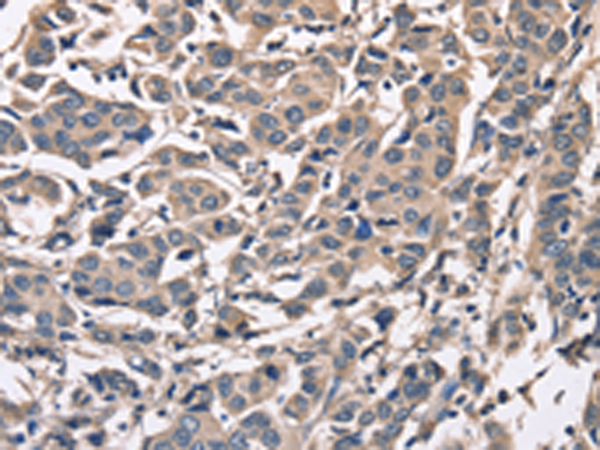


| WB | 1/500-1/2000 | Human,Mouse,Rat |
| IF | 咨询技术 | Human,Mouse,Rat |
| IHC | 1/50-1/200 | Human,Mouse,Rat |
| ICC | 技术咨询 | Human,Mouse,Rat |
| FCM | 咨询技术 | Human,Mouse,Rat |
| Elisa | 1/1000-1/5000 | Human,Mouse,Rat |
| Aliases | PBP; HCNP; PEBP; RKIP; HCNPpp; PEBP-1 |
| WB Predicted band size | 21 kDa |
| Host/Isotype | Rabbit IgG |
| Antibody Type | Primary antibody |
| Storage | Store at 4°C short term. Aliquot and store at -20°C long term. Avoid freeze/thaw cycles. |
| Species Reactivity | Human, Mouse, Rat |
| Immunogen | Fusion protein of human PEBP1 |
| Formulation | Purified antibody in PBS with 0.05% sodium azide and 50% glycerol. |
+ +
以下是3篇关于PEBP1抗体的参考文献,内容简洁明了:
---
1. **文献名称**:*RKIP suppresses breast cancer metastasis through regulation of extracellular matrix remodeling*
**作者**:Al-Mulla F, et al.
**摘要**:该研究利用PEBP1(RKIP)特异性抗体进行Western blot和免疫组化分析,发现RKIP通过抑制MMP-1的表达调控细胞外基质重塑,从而抑制乳腺癌转移。抗体检测显示,低RKIP表达与患者预后不良相关。
---
2. **文献名称**:*PEBP1 modulates autophagy and HIV-1 replication via LC3 interaction*
**作者**:Smith JL, et al.
**摘要**:通过免疫共沉淀(使用PEBP1抗体)和共聚焦显微镜技术,研究发现PEBP1通过与LC3蛋白结合调控自噬过程,进而抑制HIV-1病毒复制。抗体验证了PEBP1在感染细胞中的定位变化。
---
3. **文献名称**:*RKIP regulates neuronal apoptosis via MAPK signaling in Alzheimer's models*
**作者**:Chen Y, et al.
**摘要**:采用PEBP1抗体进行脑组织免疫染色和Western blot,揭示RKIP在阿尔茨海默病模型中通过抑制JNK/p38通路减少神经元凋亡。抗体检测显示疾病进展中RKIP表达显著下降。
---
以上文献均明确使用PEBP1抗体进行蛋白功能或表达分析,涵盖癌症、病毒学和神经疾病领域。如需扩展,可进一步检索近年研究(如2020年后)结合单细胞测序或空间组学技术的新应用。
The Phosphatidylethanolamine-Binding Protein 1 (PEBP1), also known as Raf Kinase Inhibitory Protein (RKIP), is a conserved cytosolic protein involved in regulating key cellular signaling pathways. It acts as a scaffold/modulator, primarily inhibiting the Raf/MEK/ERK cascade by binding to Raf-1. thus influencing cell proliferation, differentiation, and apoptosis. PEBP1 also interacts with G-protein-coupled receptors (GPCRs), NF-κB, and glycogen synthase kinase-3β (GSK3β), linking it to immune responses, metabolism, and neurodegenerative processes.
PEBP1 antibodies are essential tools for studying its expression, localization, and functional roles. They are widely used in techniques like Western blotting, immunohistochemistry (IHC), and immunofluorescence (IF) to quantify PEBP1 levels in tissues or cell lines. Reduced PEBP1 expression is associated with cancer progression, particularly in metastatic prostate, breast, and colorectal cancers, where its loss correlates with enhanced invasiveness and poor prognosis. Conversely, PEBP1 overexpression is implicated in Alzheimer’s disease, as it binds to tau protein, promoting pathological aggregation.
Commercially available PEBP1 antibodies are typically raised against human or murine epitopes and validated for specificity across species. Research using these antibodies has advanced understanding of PEBP1’s dual role as a tumor suppressor and neurodegeneration promoter, highlighting its potential as a therapeutic target or biomarker.
×